Outline of Turkey
The following outline is provided as an overview of and topical guide to Turkey:

The Flag of Turkey

The Emblem of Turkey
.svg.png.webp)
The location of Turkey
Turkey – sovereign Eurasian country that stretches across the Anatolian peninsula in Southwest Asia and Thrace (Rumelia) at the southeastern tip of the Balkan Peninsula in Southern Europe.[1] Turkey is a democratic, secular, unitary, constitutional republic whose political system was established in 1923 under the leadership of Mustafa Kemal Atatürk, following the fall of the Ottoman Empire in the aftermath of World War I.
General reference

Administrative regions of Turkey showing the major cities
- Pronunciation: /ˈtɜːr.ki/ (
 listen)
listen) - Common English country name: Turkey
- Official English country name: The Republic of Turkey
- Common endonym(s), i.e., in Turkish: Türkiye
- Official endonym(s):
 Türkiye Cumhuriyeti
Türkiye Cumhuriyeti - Adjectival(s): Turkish
- Demonym(s): Turks (in Turkish language: Türkler)
- Etymology: Name of Turkey
- International rankings of Turkey
- ISO country codes: TR, TUR, 792
- ISO region codes: See ISO 3166-2:TR
- Internet country code top-level domain: .tr
Geography of Turkey
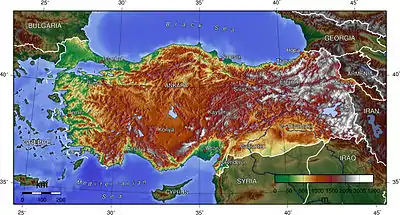
Turkey is a mountainous country.
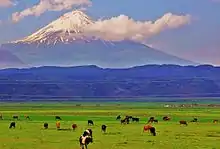
Little Ararat is in the Eastern Anatolia Region.
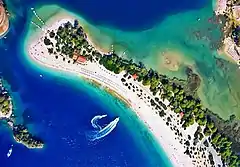
Turkey has a coastline of 7,200km.
- Turkey is: a country
- Location:
- Northern Hemisphere and Eastern Hemisphere
- Time zone
- Turkey Standard Time (UTC+03:00), since 2016
- Eastern European Time (UTC+02:00) Eastern Daylight Time (UTC+03:00), until 2016.
- Extreme points of Turkey
- High: Mount Ararat 5,137 m (16,854 ft)
- Low: Mediterranean Sea and Black Sea 0 m
- Land boundaries: 2,648 km (1645 mi)
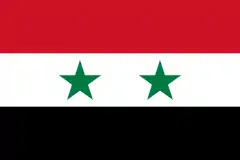 Syria (outline) 822 km (511 mi)
Syria (outline) 822 km (511 mi)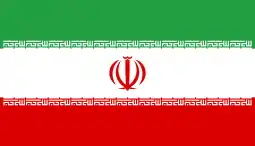 Iran (outline) 499 km (511 mi)
Iran (outline) 499 km (511 mi)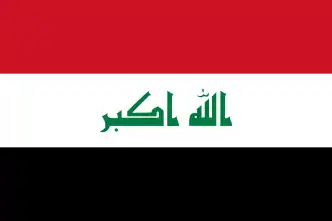 Iraq (outline) 352 km (310 mi)
Iraq (outline) 352 km (310 mi) Armenia (outline) 268 km (167 mi)
Armenia (outline) 268 km (167 mi) Georgia (outline) 252 km (157 mi)
Georgia (outline) 252 km (157 mi)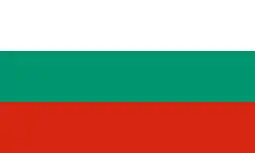 Bulgaria (outline) 240 km (149 mi)
Bulgaria (outline) 240 km (149 mi)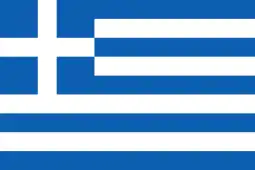 Greece (outline) 206 km (5128 mi)
Greece (outline) 206 km (5128 mi)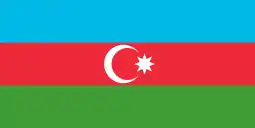 Azerbaijan (outline) 9 km (6 mi)
Azerbaijan (outline) 9 km (6 mi)
- Coastline: 7,200 km (4,474 mi)
- Population of Turkey: 82 million 19th most populous country
- Area of Turkey: 783,562km2 (302,455 sq mi) 36th most extensive country
- Atlas of Turkey
- Cities of Turkey, by population
Environment of Turkey

Snowy day in Istanbul
.jpg.webp)
Turkish Angora is a distinctive breed from Ankara

Van cat is a distinctive cat breed that enjoys swimming
- Climate of Turkey
- Environmental issues in Turkey
- Ecoregions in Turkey
- Renewable energy in Turkey
- Geology of Turkey
- National parks of Turkey
- Protected areas of Turkey
- Wildlife of Turkey
- Flora of Turkey
- Fauna of Turkey
- Amphibians of Turkey
- Birds of Turkey
- Mammals of Turkey
- Reptiles of Turkey
Geographic features of Turkey
.jpg.webp)
Antalya is in the Mediterranean Region
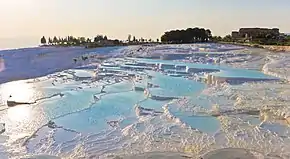
- Glaciers of Turkey
- Islands of Turkey
- Lakes of Turkey
- Mountain peaks of Turkey
- Highest major summits of Turkey
- Most prominent summits of Turkey
- Most isolated major summits of Turkey
- Anti-Taurus Mountains
- Pontic Mountains
- Sultan Mountains
- Taurus Mountains
- Yalnızçam Mountains
- Yıldız Mountains
- Volcanoes of Turkey
- Rivers of Turkey
- Büyük Menderes River
- Euphrates
- Kızılırmak
- Meriç
- Sakarya River
- Tigris
- Waterfalls of Turkey
- Valleys of Turkey
- World Heritage Sites in Turkey
Regions of Turkey
Ecoregions of Turkey
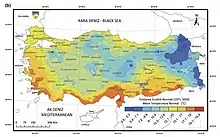
Mean temperature normal, period of 1971-2000
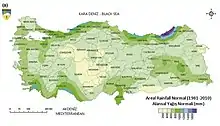
Average rainfall in Turkey, period of 1981-2000
- Ecoregions in Turkey
Administrative divisions of Turkey
Provinces of Turkey
Provinces of Turkey Turkey is divided into 81 provinces, called iller in Turkish
Districts of Turkey
Districts of Turkey The provinces of Turkey are divided into 923 districts (ilçeler; sing. ilçe).
Government and politics of Turkey

Ankara is the capital
- Form of government: Unitary presidential constitutional republic
- Capital of Turkey: Ankara
- Flag of Turkey
- Elections in Turkey
- Voting rights in Turkey
- Political parties in Turkey
- Political divisions of Turkey
National government
Legislative branch
Executive branch
- Head of state: President of Turkey, Recep Tayyip Erdoğan (12th)
- Vice President of Turkey: Fuat Oktay (1st)
- Cabinet of Turkey
- Head of government: Prime Minister of Turkey, Binali Yıldırım (27th)
Judicial branch
.jpg.webp)
A courthouse in Istanbul
- Turkey national courts
- Constitutional Court of Turkey
- High Court of Appeals of Turkey
- Supreme Council of Public Accounts
- Court of Jurisdictional Disputes
Foreign relations
International organization membership
- Member state of the Group of Twenty (G20)
- Member state of Council of Europe
- Member state of the North Atlantic Treaty Organization
- Member state of the Organization of Islamic Cooperation
- Member state of the Organization for Economic Co-operation and Development
- Member state of the United Nations
- Member state of the Turkic Council
History of Turkey
History of Turkey, by period
- Ancient period
- Ancient settlements in Turkey
- Ancient kingdoms of Anatolia
- Ottoman Empire
- Rebellions in the Ottoman Empire
Culture of Turkey
.jpg.webp)
Topkapı served as the main residence of Ottoman sultans in the 15th and 16th centuries.
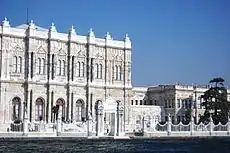
Dolmabahçe Palace is on the Bosporus with sweeping views.
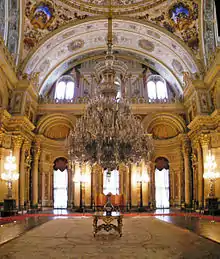
.jpeg.webp)
The chandelier in Dolmabahçe Palace was a gift from Queen Victoria.
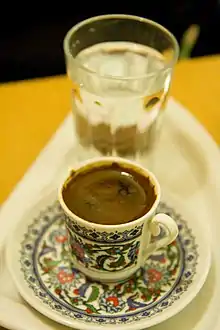
Appreciation for Turkish coffee in Istanbul led to the creation of the first ever coffeehouse in the world.

Turkey consumes more tea per capita than any other country.


- Architecture
- Cuisine
- Languages
- Media
- Museums
- Public holidays
- Traditions
- Turkophilia
- World Heritage Sites in Turkey
Art in Turkey
- Cinema
- Literature
- Museums
- Music
- Theater
- Television
- Visual arts
Law in Turkey
- Constitution of Turkey
- Separation of church and state in Turkey
- Separation of powers under the Turkish Constitution
- Civil liberties in Turkey
- Abortion in Turkey
- Assisted suicide in Turkey
- Freedom of assembly in Turkey
- Freedom of association in Turkey
- Freedom of information in Turkey
- Freedom of movement under Turkish law
- Freedom of religion in Turkey
- Freedom of speech in Turkey
- LGBT rights in Turkey
- Polygamy in Turkey
- Prostitution in Turkey
- Freedom of the press in Turkey
- Criminal law in Turkey
- Criminal law procedure in Turkey
- Capital punishment in Turkey
- Crimes against the public
- Begging in Turkey
- Sumptuary law in Turkey
- Crimes against property
- Bribery in Turkey
- Embezzlement in Turkey
- Gambling in Turkey
- Intellectual property violation
- Tax evasion in Turkey
- Crimes against animals in Turkey
- Animal cruelty laws in Turkey
- Family law in Turkey
- Marriage in Turkey
- Dissolution of marriage in Turkey
- No-fault divorce in Turkey
- Child custody laws in Turkey
- Child support in Turkey
- Parenting coordinator in Turkey
- Grandparent visitation rights in Turkey
- Adoption in Turkey
- Surrogacy in Turkey
- Child protective services in Turkey
- Emancipation of minors in Turkey
- Juvenile law in Turkey
- Intellectual property law in Turkey
- World Intellectual Property Organization
- Copyright law in Turkey
- Public domain in Turkey
- Commercial law in Turkey
- Bankruptcy in Turkey
- Consumer protection in Turkey
- Securities regulation in Turkey
- Capital Markets Board of Turkey
- Financial Regulation in Turkey
- Jurisprudence in Turkey
- Judicial review in Turkey
- Practice of law in Turkey
- Law making in Turkey
- Ballot measures in Turkey
- Executive orders in Turkey
- Legislative rulemaking in Turkey
- Treaties of Turkey
- Statutory law
- Acts of Parliament in Turkey
- Law enforcement in Turkey
Religion in Turkey

Inside the Blue Mosque
Sports in Turkey
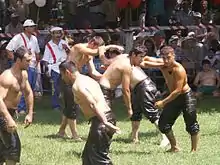
Oil wrestling is the national sport of Turkey.
Economy and infrastructure of Turkey
.jpg.webp)
Istanbul Airport is the main international airport in Istanbul.

Turkey provides high-speed rail service with speeds up to 300 km/h (186 mph).
.jpg.webp)
Butterfly Valley, home to 105 species of butterflies, is a popular tourist attraction.
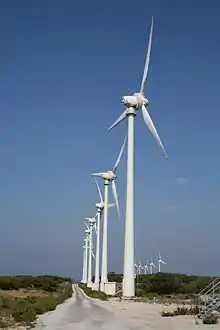
Wind farm on Bozcaada
- Economic rank, by nominal GDP(2019): 19th
- Economic rank, by GDP (PPP) (2019): 13th
- Currency of Turkey: ₺ Turkish lira
- Banking in Turkey
- Telecommunications in Turkey
- Economic history of Turkey
- National debt by Turkish presidential terms
- National debt of Turkey
- Energy in Turkey
- Energy policy of Turkey
- Electricity sector in Turkey
- Energy conservation in Turkey
- Energy policy of Turkey
- Health care in Turkey
- Industry trade groups in Turkey
- Tourism in Turkey
- Transportation in Turkey
- Trade policy of Turkey
- Wealth in Turkey
- Household income in Turkey
- Income inequality in Turkey
- Personal income in Turkey
- Poverty in Turkey
- Welfare in Turkey
- Water supply and sanitation in Turkey
Education in Turkey
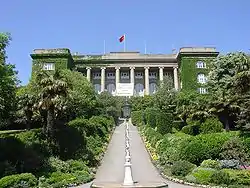
Robert College is a selective high school in Turkey.

Galatasaray Lisesi (gate pictured) is a public high school in Istanbul that dates back to 1481.
- Higher education in Turkey
- Medical education in Turkey
- Legal education in Turkey
- List of schools in Turkey
- List of private schools in Turkey
- List of international schools in Turkey
- List of yeshivas in Turkey
- List of public schools in Turkey
- Lists of universities and colleges
- List of private schools in Turkey
- Anti-schooling activism in Turkey
- Department of Education in Turkey
- Foreign language education in Turkey
- Homeschooling in Turkey
See also
- Topic overview:
- All pages with titles beginning with Turk
- All pages with titles beginning with Turkey
- All pages with titles beginning with Turkish
- All pages with titles containing Turk
- All pages with titles containing Turkey
- All pages with titles containing Turkish
References
- "Turkey". The World Factbook. United States Central Intelligence Agency. July 14, 2009. Retrieved July 23, 2009.
This article is issued from Wikipedia. The text is licensed under Creative Commons - Attribution - Sharealike. Additional terms may apply for the media files.
.jpg.webp)

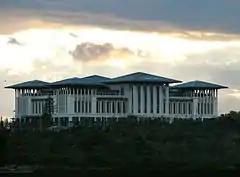
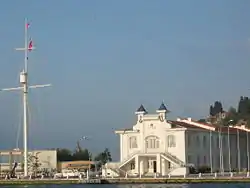

.jpg.webp)


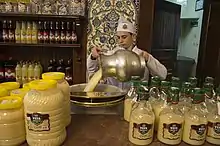

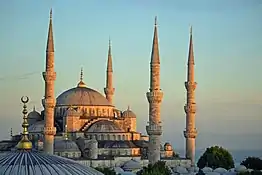

%252C_circa_1899%252C_Haydarpasha_Quarter%252C_Istanbul_(3438422679).jpg.webp)
.JPG.webp)

